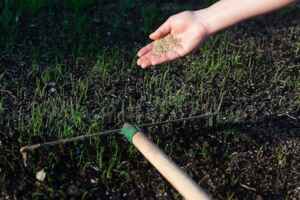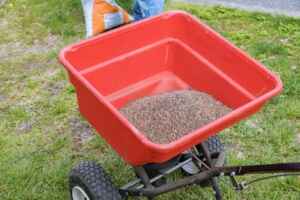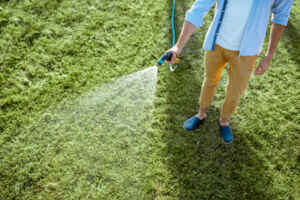If your lawn is looking a little worse for wear after a long winter, it might be time to think about overseeding. Overseeding your lawn in the spring is a great way to ensure a healthy, green lawn all season long. This is especially helpful if your lawn is starting to look thin or patchy. Overseeding also helps to crowd out weeds and improve the overall health of your lawn by improving the density of your grass, which makes it more resistant to weeds, pests, and disease. You should overseed your lawn every year. Your lawn experiences harsh winters annually so it needs the assistance of new seeds and maintenance annually as well. So, look no further if you are wondering how to overseed your lawn in the Spring?
Overseeding is a pretty simple process, but there are a few things you’ll need to do to make sure it’s done correctly. It also helps to know exactly what overseeding is and the best time to do it for maximum results.
- Prep Your Lawn (This Includes Clearing, Cutting, and Cleaning Your Area)
- Pick a Seed (Not All Lawns Use the Same Seed)
- Lay the Seed
- Water the Seeded Area
Now that you have an idea of how to oversee your lawn in the Spring, let’s examine what overseeding is, why it’s important, and more! So, keep reading to find out!

What Is Overseeding?
Overseeding simply means adding or planting new seeds to your existing lawn to thicken it up, fill in bare patches, or simply give it a boost of color. While overseeding can be done at any time of year, the best time to overseed your lawn is in the early spring. This is because the weather is getting warmer but the temperatures haven’t started to rise too much. Also, longer days provide ideal conditions for germination and growth. This is so the grass can take root before the summer heat arrives. Late summer or early fall is also a good time to overseed, but you’ll need to make sure you water the new seed regularly until frost arrives. Overseeding is relatively simple and just requires a few tools and supplies.
Why Is Overseeding Important?
Overseeding your lawn is important for a number of reasons. First, it helps to thicken up your lawn, making it less likely to experience bare spots or weed problems. Second, overseeding can help to improve the overall health of your lawn by introducing new and healthy grass seedlings. Finally, overseeding provides an opportunity to add new grass varieties to your lawn that may be more resistant to pests or diseases. Ultimately, overseeding is a great way to keep your lawn looking its best and gives it a much-needed refresh to help it recover from the wear and tear of winter.
Why Should You Overseed In the Spring?
The spring is the best time to overseed your lawn because the conditions are ideal for grass seed germination. The soil is moist and the air temperature is warm, but not hot. Overseeding in the spring will ensure that your lawn has a thick, green carpet of grass by summer.
If you live in an area with a cool climate, late spring or early summer may be the best time to overseed. This will give the grass seeds enough time to germinate and establish themselves before winter arrives.
How to Prepare Your Lawn for Overseeding
Before you start the overseeding process you will have to take a few steps to prepare your lawn.
The first step before beginning, you want to make sure your lawn is free of debris especially if you have had a recent storm or any other debris that may have accumulated over the winter months. This means you’ll want to clear the area of any branches or tree limbs that may have fallen into your yard. This will help ensure that new grass seeds can reach the soil and take root.
Next, you should mow your yard. So that your grass is cut short enough that the seed will be able to reach the soil.
Lastly, you will need to clean up your yard. You’ll need to rake up any dead leaves or leftover small pieces of debris that have collected on your lawn over winter. Don’t forget the dead grass that you may have after your fresh mow. Having your lawn clean and clear will help ensure that the new seed has direct contact with the soil so that it can germinate properly.
Picking Your Seed
Before you actually start the seeding process you will need to make sure that you choose the right seed: Not all grasses are created equal! Be sure to choose a type of grass that will do well in your climate and soil type.
There are a few things you should take into account when choosing seed for overseeding, such as:
- The Type of Lawn You Have
- What Your Climate Is Like
- The Kind of Soil You Have
- How Much Sun and Shade Your Lawn Gets
During this step, it’s often a good idea to test your soil to see what nutrients it might be lacking. This will help you choose the right fertilizer to use along with your new seed. It’s also important to test your soil to make sure that it is healthy enough to support new growth.

Testing Your Soil
Here are a couple of ways that you can test your soil before overseeding:
1. Get a Soil Testing Kit from Your Local Garden Center or Online.

2. Follow the Instructions Included with Your Kit to Collect a Sample of Soil From Your Lawn.
3. Send the Soil Sample to a Laboratory for Analysis.
Be sure to include any specific instructions from your kit on how to prepare the sample for shipping.
4. Once You Receive the Results of Your Soil Test, Review Them Carefully.
If the results show that your soil is healthy, you can proceed with overseeding. If the results indicate that your soil needs some improvement, take steps to address the issue before overseeding. For example, if your soil is too acidic, you can add lime to raise the pH. If it’s too alkaline, you can add sulfur to lower the pH.
By taking the time to test your soil before overseeding, you’ll give your lawn the best chance for a successful spring growing season.
Starting the Overseeding Process
The first thing that you should do in the overseeding process is started by dethatching or aerating your lawn to loosen up the soil. Aerating your lawn helps to improve drainage and prevents compaction and will help the new seed to take root more easily. If you have a small lawn, you can probably get away with using a hand aerator. However, if you have a large lawn, you’ll need to use a gas-powered aerator or rent one from a local hardware store.
Next, spread a thin layer of seed over the entire lawn. This can be done either by hand or with a spreader. If you’re overseeding a large area, a spreader will make the job much easier. Just make sure that the seed is spread evenly over the entire area. Using either a hand-held spreader or a mechanized drop spreader will help ensure that the spread is even. Once the seed is spread then grab a rake and lightly rake the seeded area again to help ensure good seed-to-soil contact. It is important for the seeding to actually reach the soil so it doesn’t just get washed away by water.
Once you’ve seeded your entire lawn, water it thoroughly using a sprinkler or hose attachment. Make sure the water is also spread evenly and not pooled in areas making puddles. It is important to keep it moist until the new grass begins to grow.
Watering Your Overseeded Area
Be sure to water regularly, especially during the first few weeks after planting. Watering regularly will help your new seed germinate and grow which will ensure that your new grass comes in thick and healthy.
Watering twice a day should do the trick, once in the morning and once at night. However, make sure not to let the soil dry out completely between waterings. The goal is to keep the top layer of soil moist but not soaked. So, if you’re unsure whether or not you’re watering enough, err on the side of too much rather than too little water. Too little water will cause the new seedlings to die, while too much water will simply wash them away.

After about two weeks (give or take), you should start seeing new growth popping up through the soil. At this point, you can begin cutting back on watering until you’re only watering once per day—again, making sure not to go overboard and let the soil dry out completely between waterings. After another week or two (depending on weather conditions), your newly overseeded lawn should be thick and green and ready for all your springtime outdoor activities!
Conclusion
Springtime is the perfect time of year to freshen up your lawn by overseeding it with fresh grass seed. Overseeding has many benefits—it helps improve density, inhibits weed growth, and strengthens against disease and pest. Also, it’s pretty easy to do yourself with just a little knowledge and effort. Spring has the perfect temperatures to best help your seed grow and will make sure that it is ready to go for all of your summertime festivities. By following these steps for how to overseed your lawn in the Spring every year, you will be improving not only the look of your lawn but its life of it as well.

